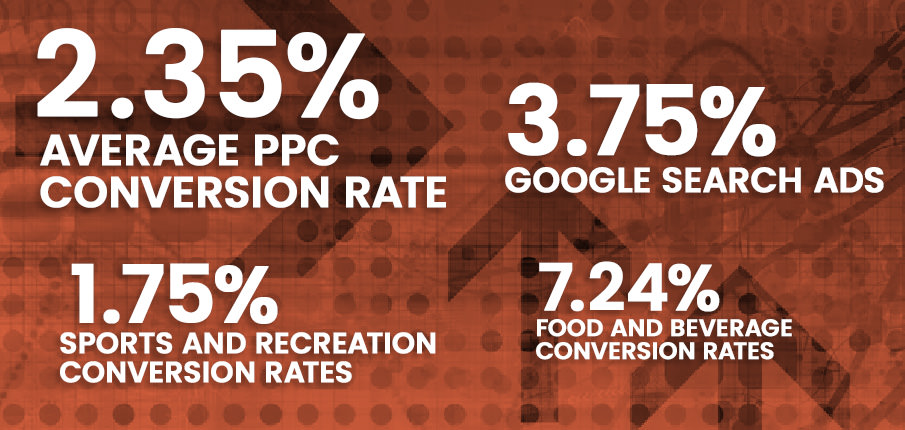In the world of digital marketing, conversion rates are key…unless you like fumbling around in the dark, spending money on campaigns and blindly trusting that they’re working.
You know what we like? Flashlights. Oh, and metrics, too.
Unless your last name is Bezos or Buffett, you probably don’t have money to burn. We bet you’d prefer to invest your marketing dollars in strategies that actually, you know — pay off. That’s where conversion rates come in.
Calculating PPC Conversion Rates
(Warning: Math is Involved)

PPC conversion rates are the percentage of people who click on your PPC ad and complete a desired action, such as making a purchase, signing up for a newsletter, or filling out a contact form. If you’re a burger joint selling value meals, they’re the folks who want to “Super Size” it.
To calculate your conversion rate, divide the number of users who complete the desired action by the total number of visitors.:
Conversion Rate (%) = (Number of Conversions / Total Number of Clicks) x 100
For example, if your search ad receives 100,000 clicks in a month, and 2,000 people completed a transaction, the conversion rate for that month would be 2%.
(2,000 / 100,000) x 100 = 2%
Figuring out the conversion rate isn’t hard. But knowing whether it’s a good conversion rate is another story.
Tracking Conversions
Ecommerce campaigns are straightforward because you're typically tracking completed transactions. With proper tracking, you will see exactly what your return on ad spend is for each keyword, search term, site placement, and demographic. Once high-value assets (keywords, placements, demographics) are identified, finding ways to increase your conversion rate through landing page and ad optimization should increase your return on ad spend. Additionally, you use this information to bid adjust on products that yield higher return.
You can and probably should set up secondary events such as Add To Cart, View Related Products, and Email Subscription Rate. These metrics will help you understand the customer journey and complete conversion process.
The process for lead generation relies on metrics such as form fills, emails, phone calls, online chats, and more. Lead generation measures all the ways online traffic is contacting you through your website. However, leads need to be qualified. Analytics can track a Request A Quote, but it has no way of knowing whether the request was a good lead or a bad lead. Leads from paid traffic need a solid process that allows for tracking and valuation in order to improve meaningful conversions that yield a return on ad spend. Often, lead generation campaigns — especially those that use display ads — show high conversion rates across many smaller/unknown sites. While these look good on paper, the majority are likely never to become qualified leads.
Overall, it’s a good idea to compare your conversion rates to industry standards, but do so with a grain of salt. Keep in mind that different tracking methods mean not all conversions are created equal. You are better off with a 1% conversion rate and a 100x return on ad spend than a 20% conversion rate with only a 2x return on ad spend.
Conversion Rates by Industry

Here’s a general rule of thumb: the average PPC conversion rate across all industries is 2.35%.
That’s a benchmark, though. Conversion rates vary widely by industry. The type of ad and specific desired action also play a role.
What is a good Google conversion rate? Well, it’s actually higher, averaging around 3.75% for Google Search Ads. Again, there are notable differences depending on the industry. Sports and recreation companies, for example, see conversion rates around 1.75%, while some food and beverage companies can reach conversion rates of 7.24%.
Must be a lot of Super Sizing taking place there!
Conversion rates are important, but they are often misleading and may be over- or under- reported depending on your conversion tracking setup. If Company A is tracking all micro events (page views, time on page, scroll depths) as conversions, and Company B is only tracking leads or sales, then Company A will most likely have a much larger conversion rate…but isn’t necessarily outperforming Company B.
Focus on the Return on Ad Spend
You’ll still want to focus on conversion rates, but your main priority is generating a good return on ad spend (ROAS), which is the conversion value / cost.
When it comes to paid advertising, your end goal is to generate the most return on your ad spend. When looking at conversion rates, certain keywords, sites, or demographics might generate a very high conversion rate but bring in low-quality leads and/or a low return on ad spend.
Knowing which key metrics to look at, and which ones carry less weight, will help you unlock a successful Google Ads conversion rate strategy!
Learn more about Conversion Rate Optimization or try our Conversion Rate Calculator